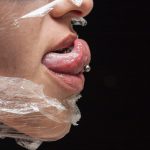
Body piercing has a long history having been practiced since as long ago as the neolithic era. Common oral piercing sites include the lip upper frenulum and the tongue. They are typically metal or plastic and have a range of forms. A number of oral complications have been reported including tooth injuries, gingival recession and severe local periodontal damage infections.
The aim of this review was to evaluate the influence of oral piercings on the periodontal health status in adult patients.
Methods
A review protocol was registered with the PROSPERO database. Searches were conducted in the Medline, Embase, Cochrane Central Register of Controlled Trials (CENTRAL) and OpenGrey databases. Randomised controlled clinical studies (RCTs), controlled clinical studies, prospective or retrospective case series, cross-sectional or case–control studies published in English or German involving at least 10 patients and reporting on periodontal outcomes were considered. The primary outcome was probing pocket depths (PPD) with clinical attachment loss (CAL), gingival recession, bleeding on probing (BOP), and plaque score (PI) as secondary outcomes. Two reviewers independently selected studies and extracted data. Study quality was assessed using case-series appraisal tool (Maga et al 2012). A vote-counting method was used to synthesise the results.
Results
- 8 studies (2 case-series, 6 cross-sectional studies) involving a total of 408 patients were included.
- Sample sizes ranged from 18 – 110 patients.
- The included studies had 236 lip piercings and 236 tongue piercings.
- Wearing times varied from 1 month to 19 years with one study having a minimum wearing time of one year.
- In patients with tongue piercings, teeth adjacent to the piercing showed increased PPD (3 of 5 studies), more clinical attachment loss [CAL] (3 of 4 studies), more gingival recessions (4 of 4 studies) and a higher bleeding on probing (2 of 3 studies) compared with control teeth.
- In patients with lip piercings, teeth adjacent to the piercing demonstrated more gingival recessions (3 of 4 studies) compared with control teeth.
- Time since piercing placement was associated with localized periodontal destruction in patients with tongue and/or lip piercings (4 of 7 studies).
Conclusions
The authors concluded: –
The available evidence from eight studies suggests negative effects of tongue piercings on several periodontal health parameters of adjacent teeth, while gingival recessions were frequently detected in patients with lip piercings.
Comments
A protocol for this review was registered with the Prospero database and a number of databases searched. However, a language restriction to English and German may have excluded some relevant studied. In addition, the review was narrowly focussed on periodontal outcomes. A previous review by Passos et al., (Dental Elf – 6th Jul 2022) looked more broadly at any oral complications from oral piercings including 54 studies with 38 studies reporting on some type of periodontal issue. Other reviews have also reported on adverse oral effects from oral piercings (Dental Elf – 19th Feb 2015). However, while a growing number of studies a reporting on these adverse effects the quality of the studies is low and future studies should be reported using international guideline for reporting on observational studies and care reports using common outcome sets.
Links
Primary Paper
Difloe-Geisert JC, Müller JS, Weiger R, Walter C. Impact of oral piercings on periodontal health – A systematic review. Int J Dent Hyg. 2023 Sep 11. doi: 10.1111/idh.12734. Epub ahead of print. PMID: 37691549.
Other references.
Moga C, Guo B, Schopflocher D, Harstall C. Development of a Quality Appraisal Tool for Case Series Studies Using a Modified Delphi Technique. Institute of Health Economics (IHE); 2012.
Dental Elf – 6th Jul 2022
Dental Elf – 19th Feb 2015
Picture Credits
Photo by engin akyurt on Unsplash
